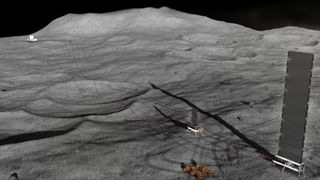
Artist’s illustration of a power system on the moon. NASA plans a sustained presence on the moon and eventually Mars. Safe, efficient, reliable energy will be key to future robotic and human exploration.
(Image credit: NASA)
NASA is wrapping up the design phase of a project to develop concepts for a small, electricity-generating nuclear fission reactor for use on the moon.
The Fission Surface Power Project aims to develop safe, clean and reliable energy sources on the moon, where each nighttime lasts around 14.5 Earth days. Such a system could play a big role in the agency’s Artemis program for lunar exploration.
NASA and the U.S. Department of Energy announced contracts to three companies — Lockheed Martin, Westinghouse and IX (a joint venture of Intuitive Machines and X-Energy) — for the initial phase back in 2022.
Related: NASA funds nuclear probes for icy moons, huge new space telescopes and other far-out tech ideas
The trio were tasked with submitting an initial design for a reactor and subsystems, estimated costs and a development schedule that could pave the way for powering a sustained human presence on the lunar surface for at least 10 years.
“The lunar night is challenging from a technical perspective, so having a source of power such as this nuclear reactor, which operates independent of the sun, is an enabling option for long-term exploration and science efforts on the moon,” Trudy Kortes, program director for technology demonstration missions within NASA’s Space Technology Mission Directorate, said in a Jan. 31 statement.
A reactor could be especially useful at the lunar south pole, where permanently shadowed regions are thought to have trapped water ice and other volatiles.
NASA next plans to extend Phase 1 contracts to refine the project’s direction for Phase 2, which involves final reactor design for a lunar demonstration. Open solicitation for Phase 2 is expected to open in 2025.
“We’re getting a lot of information from the three partners,” said Lindsay Kaldon, Fission Surface Power project manager at NASA’s Glenn Research Center in Cleveland. “We’ll have to take some time to process it all and see what makes sense going into Phase 2 and levy the best out of Phase 1 to set requirements to design a lower-risk system moving forward.”
After Phase 2, the target date for delivering a reactor to the launch pad is in the early 2030s, NASA stated.
The agency set requirements for a 40-kilowatt reactor that uses low-enriched uranium and weighs no more than 13,200 pounds (6,000 kilograms). Beyond certain constraints, the agency allowed for flexibility, allowing the companies to bring creative and diverse approaches for technical review.
In the U.S., 40 kW can, on average, provide electrical power for 33 households, according to NASA.
Artist’s impression of two astronauts working on the moon during Artemis lunar operations. Such operations might be supported by nuclear power. (Image credit: NASA)
The reactor plan is one of a number of new nuclear plans for space, including launching a nuclear-powered spacecraft, named DRACO, by early 2026.
NASA also recently awarded contracts for developing more efficient Brayton power converters, which are essential for converting thermal power from nuclear fission into electricity, to Rolls Royce North American Technologies, Brayton Energy and General Electric.
Join our Space Forums to keep talking space on the latest missions, night sky and more! And if you have a news tip, correction or comment, let us know at: community@space.com.
Breaking space news, the latest updates on rocket launches, skywatching events and more!
Andrew is a freelance space journalist with a focus on reporting on China’s rapidly growing space sector. He began writing for Space.com in 2019 and writes for SpaceNews, IEEE Spectrum, National Geographic, Sky & Telescope, New Scientist and others. Andrew first caught the space bug when, as a youngster, he saw Voyager images of other worlds in our solar system for the first time. Away from space, Andrew enjoys trail running in the forests of Finland. You can follow him on Twitter @AJ_FI.
>>> Read full article>>>
Copyright for syndicated content belongs to the linked Source : Space.com – https://www.space.com/nasa-moon-nuclear-reactor-project-first-phase-complete
